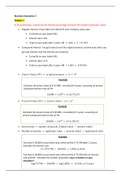Business Economics 5
Chapter 1
In those formulas, i stands for the interest percentage and n for the number of periods / years.
• Singular interest: If you take out interest of your company every year.
➢ Currently on your bank € 80,-
➢ Interest rate is 6%
➢ Total on your bank after 5 years: 80 × 0,06 × 5 = € 104
• Compound interest: You get interest over the original amount, and the years after you
get also interest over the interest you received
➢ Currently on your bank € 80,-
➢ Interest rate is 6 %
➢ Total on your bank after 5 years: 80 × 1,065 = € 107,06
• 𝐹𝑢𝑡𝑢𝑟𝑒 𝑉𝑎𝑙𝑢𝑒 (𝐹𝑉) = 𝑜𝑟𝑖𝑔𝑖𝑛𝑎𝑙 𝑎𝑚𝑜𝑢𝑛𝑡 × (1 + 𝑖)𝑛
Example
Calculate the future value of € 15.000,- invested for 8 years, assuming an annual
compound interest rate of 7%.
15.000 × 1,078 = € 25.772,79
• 𝑃𝑟𝑒𝑠𝑒𝑛𝑡 𝑉𝑎𝑙𝑢𝑒 (𝑃𝑉) = 𝑓𝑢𝑡𝑢𝑟𝑒 𝑣𝑎𝑙𝑢𝑒 ÷ (1 + 𝑖)𝑛
Example
Calculate the present value of € 20.000,- receivable for 5 years, assuming an
annual compound interest rate of 7%.
20.000 ÷ 1,075 = € 14.259,72
• Interest rate = number of periods √(future value ÷ present value)
• Number of periods = log(future value ÷ present value) ÷ log(interest rate)
Example
You have € 30.000 on your bank now, which will be € 73.798 after 11 years.
Calculate the interest rate.
11 √(73.798 ÷ 30.000) = 1,085, so 8,5%
You have € 30.000 on your bank now, which will be € 73.798 with an interest
rate of 8,5% . Calculate the number of periods. Log is a button on your
calculator!
log(73.798 ÷ 30.000) ÷ log(1,085) = 11,033, so 11 years
, Chapter 2
• Interest: added as percentage to the present value to arrive at the future value
• Discount: deducted as a percentage from the future value to arrive at the present value
Example
This is an example for the future value when a certain amount is invested every year
Calculate the future value on December 31st 2020 when € 1.500,- will be invested for a
period of 5 years, each year, starting January 1st 2015, assuming an annual compound
rate of 5%.
• Start with drawing a time line
/ ’15 / ’16 / ’17 / ’18 / ’19 / ’20 / ’20
€ 1.500 € 1.500 € 1.500 € 1.500 € 1.500
• The amount invested at / ’15 will be in the company for 6 year, the one
invested in 2016 will be in the company for 5 years, the one invested in 2017 for
4 years and so on.
This calculations consists out of three formulas whereas the first one is deducted from
the second one which will give you the third and final formula
1. 1 × 𝐹𝑉 = 1.500 𝑥 ( 1,056 + 1,055 + 1,054 + 1,053 + 1,052 )
The equation can be changed, however, you have to do it on both sides of the = sign. In
this example: multiply both sides. This gives formula two.
2. 1, 05 × 𝐹𝑉 = 1.500 𝑥 ( 1,057 + 1,056 + 1,055 + 1,054 + 1,053 )
After making the second equation you deduct the first formula from the second formula
(numbers from formula one and two which are the same). This gives formula three.
3. 𝐹𝑉 = 1.500 𝑥 ( 1,057 − 1,052 ) ÷ 0,05
Note: The result from the numbers which stand for the FV is put at the end in formula
three. In this example it is marked red!





